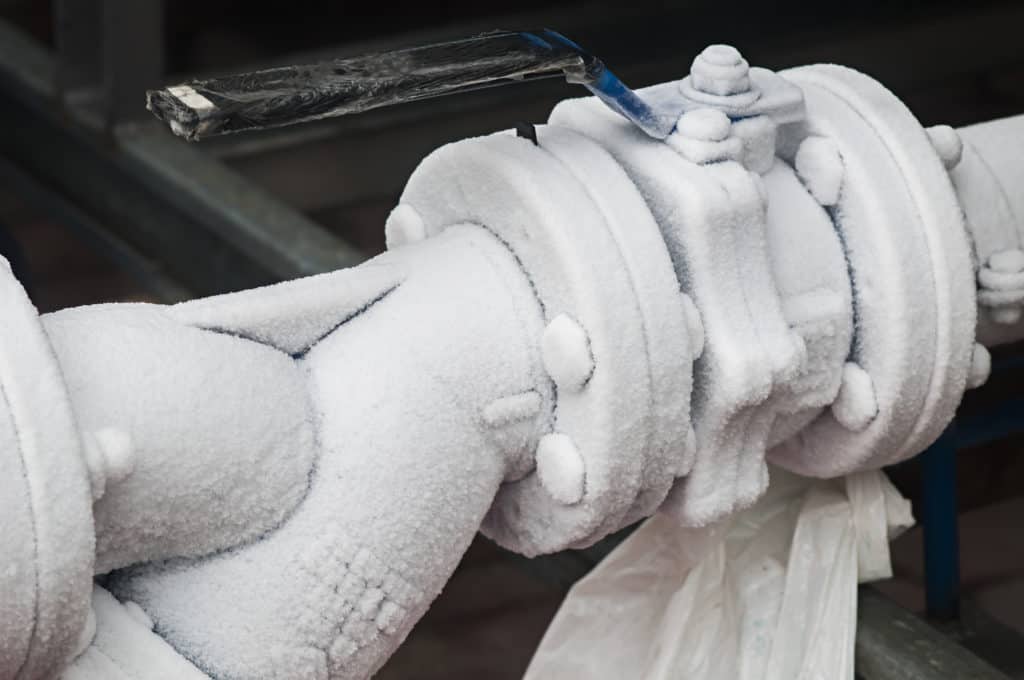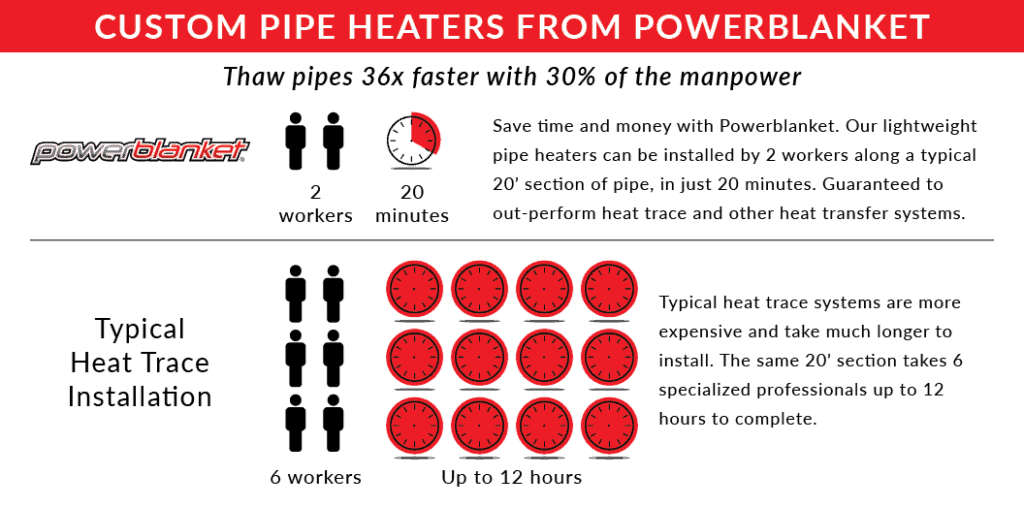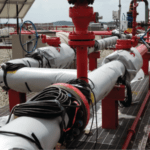Over half the U.S. population struggles to thaw frozen pipes each winter season. When water freezes, it expands. And when this occurs within a piping system, it can be disastrous. The costs associated with frozen and broken water lines is enormous, not to the mention the nightmare caused by water damage. While an ounce of prevention might be worth a pound of cure, methods for preventing frozen pipes previously have been costly and ineffective at best. It’s better to just thaw pipes with Powerblanket.
How To Tell If Your Pipes Are Frozen
Ambient Temperatures
You first sign of trouble is the onset of sub-freezing temperatures. Outdoor piping, and pipes located within exterior walls have the greatest chance of freezing. Keep a close eye on the weather and watch for potential freezes. It is especially important to monitor this when you live in areas that do not freeze often. For example, buildings in the US South, which rarely sees sub-freezing temperatures, do not usually have protective pipe insulation. Frozen pipes often catch these locations off-guard.
Visible Frost
Not all pipes are visible. However for maintenance and shut off, a small section of pipe will surface for valve placement. Inspect these visible sections of pipe for exterior frost accumulation.
Flow Problems
Another sign is when you try to turn on a faucet and the water flow has slowed to a trickle, or come to a full-stop. If this happens, there is likely a frozen blockage within the piping.
Unpleasant Odors
If you notice a strange smell coming from drains and faucets, there is possibly a section of frozen pipe. This is due to ice blockage preventing the flow within the pipe, and odors have no other way out except to flow back up out of your faucets or drains.
How To Thaw Frozen Pipes
Until recently, best methods to thaw pipes included heat trace, insulation, or expensive high wattage heaters which simply aren’t practical.
Heat Trace
This method runs electric cables along the length of the surface of the pipes. Some systems run constantly, which can cause a very expensive electricity bill. Other systems contain regulators to turn heat on or off as needed. However one problem associated with heat trace systems is their need to be replaced to avoid fires or injuries due to short circuits. They are also labor intensive and time consuming to install, repair, and replace.
Insulation
Insulation within wall framing typically protects pipes located within interior walls. Outdoor pipes and valves are sometimes insulated after installation. Usually, insulation is categorized by R-value, which measures a material’s heat flow resistance. These insulation costs add up quickly. For this reason, consumers are often tempted to purchase and install lower R-value insulation in the quest to save money.
High Wattage Heaters
Sometimes sub-freezing temperatures catch people off guard. When this happens, some home and business owners desperately turn to space heaters and heat lamps to thaw pipes. Unfortunately radiant heating spends more time and energy heating the air instead of the pipes themselves. Direct conductive heating is the most cost effective form of heat transfer for thawing pipes.
Powerblanket Pipe Thawing Solutions
Keeping operations running during the winter months can be very difficult. Weatherproof your business with Powerblanket’s cold weather construction solutions. These advanced heaters offer freeze protection for your entire pipe and manifold system. The simple design eliminates the need for expensive work crews to install or remove heat trace, insulation, and cladding.
Powerblanket pipe wraps provide maximum freeze protection for a wide variety of applications. Heating, insulating, and protecting fluids from harsh outdoor environments is our specialty. They are available in multiple lengths and diameters to fit any pipe size. In addition, our world class engineers custom fit your heaters to fit around any valves, manifolds, or gauges on your piping.
The Powerblanket pipe wrap’s innovative “all-in-one” product design greatly reduces installation time, eliminates the need for multiple product purchases, and reduces labor costs. Installing pipe wraps on long sections will thaw pipes quickly, maintain flow, and maximize production even in the harshest of winter conditions.
Powerblanket Pipe Heater Benefits
- Maximum freeze protection to -40°F / -40°C
- Engineered to maintain flow
- Reduce downtime and increase profitability
- Easy to install, uninstall, and reinstall
- Rapid thawing for frozen or gelled pipes
- Certified to UL/CSA safety standards
Contact us today to find the perfect custom pipe heating solution for your needs at 866.945.4203 or [email protected].
Frequently Asked Questions
Is it OK to let frozen pipes thaw on their own?
No, it's not advisable to let frozen pipes thaw on their own, as this can lead to pipe bursts and water damage; instead, use controlled heating methods like Powerblanket pipe wraps to safely thaw them.
Will pouring hot water down the drain unfreeze pipes?
Pouring hot water down the drain can help unfreeze pipes, but using a more controlled heat source, such as a hair dryer or heating pad, is safer and more effective.
How do you unfreeze pipes you cannot access?
For pipes you cannot access, apply heat indirectly using methods like wrapping the area with heat tape or using a space heater nearby, ensuring not to use open flames to avoid damage.
What to do if your pipes freeze overnight?
If your pipes freeze overnight, immediately turn off the main water supply, open the faucet to allow water flow once thawed, and apply heat to the frozen section using a hair dryer or similar device.
Pipe heaters from Powerblanket keep your fluids flowing all year long, providing freeze protection for your entire system.





